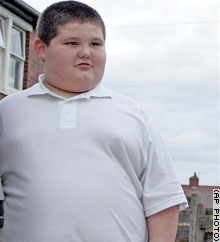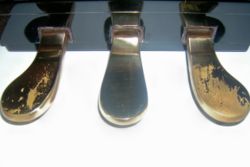 Con Anima, a vocal group from St. Petersburg Russia, will perform at Mount Vernon Presbyterian Church on Saturday March 3rd, 2007 at 7pm. The concert is free. Read more information about the Con Anima Russian choir.
Con Anima, a vocal group from St. Petersburg Russia, will perform at Mount Vernon Presbyterian Church on Saturday March 3rd, 2007 at 7pm. The concert is free. Read more information about the Con Anima Russian choir.
Real World Augustus Gloop
 I’ve been writing music for Charlie and the Chocoloate Factory, including a theme song for Augustus Gloop. I ran across this article today about a boy in London who is 8 years old and weighs 200 pounds. His mother says he will only eat junk food and she refuses to stop feeding him.
I’ve been writing music for Charlie and the Chocoloate Factory, including a theme song for Augustus Gloop. I ran across this article today about a boy in London who is 8 years old and weighs 200 pounds. His mother says he will only eat junk food and she refuses to stop feeding him.
The English social services there actually reviewed whether he should be taken out of the home. They ruled today that he can stay, which is a good thing for him as it sounds like the food is pretty good.
Gosh darn it all, his mother tries to feed him fruits and vegatables but “he just spits them out.”
Hey, this is the REAL AUGUSTUS GLOOP! Read the Augustus Gloop CNN Article.
The Mysterious Middle Piano Pedal
The nefarious middle piano pedal, the bane of piano teacher and student alike. Yes, it does have a function, but rarely used in contemporary music.
Piano pedals from left to right: una corda, sostenuto and damper.
THE THREE PIANO PEDALS
Left Pedal
The left piano pedal is called the “una corda” pedal, or in common usage called the “soft” pedal. When the pedal is pressed the piano becomes softer. In most upright pianos this is done by dropping a piece of felt between the hammers and the strings which softens the attack. In grand pianos the entire keyboard will shift so that the hammers only hit two strings instead of three. (Grand pianos have three strings per note, so only hitting two of those strings reduces the volume by roughly 1/3). The word “una corda” in Italian means “one strings”. So why is it called “one string” when it actually hits two? The inventor of the piano, Cristofori (1655-1731), made his pianos with two strings per note instead of three like we use today. He also included a “soft pedal” which would hit only one string instead of two, so it made sense to call it “una corda”. His soft pedal had a larger impact on the sound by decreasing volume by one half instead of one third.
Right Pedal
The right piano pedal is called the “damper” pedal (commonly the “sustaining” pedal). This is the most commonly used pedal on the piano and is often simply referred to as “the pedal” because it is used so much. When the pedal is pressed, the dampers lift off the strings so the sound continues to vibrate. This also allows strings that have not been struck to ring sympathetically with the overtones of ringing strings. This creates a fuller sound. This pedal is often overused to cover up poor technique. Of course, it doesn’t actually cover up the poor technique, but the player often thinks it does. In practicing it’s usually good advice to practice without the sustain pedal in order to focus on good finger technique and interpretation. Once technique is mastered, then add the pedal.
Middle Pedal
The middle piano pedal is called the “sostenuto” pedal on grand pianos or the “practice pedal” on uprights. The middle pedal has different functions depending whether it is on an upright piano or full grand piano. Many spinet pianos (smaller upright pianos, the kind most people have in their living room) do not have a middle pedal at all. On grand pianos, the middle pedal will sustain any notes which are currently pressed. On upright pianos, this pedal will sustain any notes in the lower octave.
It is not often you will come across the necessity for the middle piano pedal. But it does occur fairly often in piano transcriptions by Franz Liszt. A good example is the Liszt transcription of Prelude and Fugue in C Major by JS Bach (BSV 544 – S462/2). This piece uses Bach’s common ground or pedal tone sustaining in the low actives with fast sixteenth note runs over the top. And that is the reason for this entire post. I am currently working on that Liszt transcription and thought it would be a great opportunity to explain the piano pedals in detail.
The middle piano pedal is the red headed step child of the pedal family. You may very well find on your spinet piano at home that it does absolutely nothing at all, or is just a soft pedal. You would probably not want to play a Liszt piece on a small spinet anyway, so it all works out in the wash.
Conrad’s Practical Pedal Postulates
Some piano teachers may bristle at this, but short of preparing concert material, my practical approach to pedals is this:
Right pedal sustain – Use to taste but reset often so the sound does not become muddy.
Middle Pedal sostenuto – Don’t use it (very rare)
Left Pedal Soft – Use to soften piano when accompanying vocalists or playing background music.
